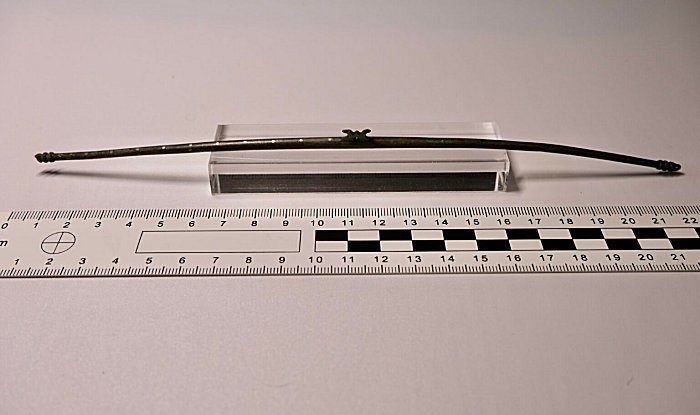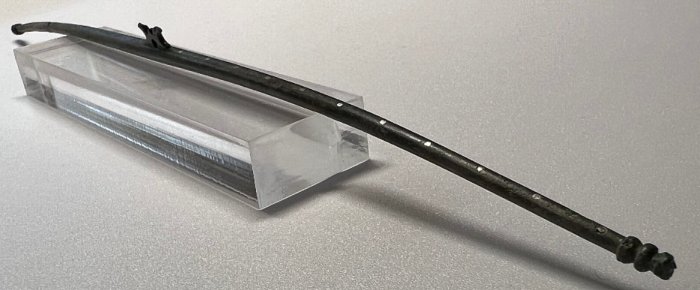Conny Waters – AncientPages.com – One of the first finds in new excavation reveals a glimpse of Roman life at Milecastle 46 on Hadrian’s Wall.

Steelyard beam. Image credit: The Vindolanda Trust
The top layers of the Hadrian’s Wall Milecastle 46 excavations at Magna were not anticipated to yield a flurry of artefacts or inscriptions.
The milecastle site, along with the adjacent section of Hadrian’s Wall and the Fort of Magna were heavily stone robbed in the 14th century, much of that stone probably being used to build the nearby Thirlwall Castle.
Despite a sparsity of standing remains by the fourth week into the dig the impressive foundation stones of the milecastle are starting to emerge and alongside the outer wall of the structure a wonderful find was recently uncovered that gives us an insight into the sort of activities that took place there almost 2000 years ago.
An exceptionally fine example of a small and delicate equal arm steelyard beam (or yard) was found during week three of the work.
“This was a part of the site we had been working in the week before but there had been no signs of any artefacts at all in this area; the extremely heavy rain that we had over the weekend helped to wash the last cover of soil from one end of the steelyard beam, revealing just a few centimetres of the artefact,” Rachel Frame, the Senior Archaeologist at the Magna site said in a press release.
“At first, I thought it could be a large pin or needle, but it became clear as the find continued to be uncovered and features like the central fulcrum were revealed, that it was something much more special and could tell us a great deal about how the milecastle may have been used”.

Silver insets on beam. Image credit: The Vindolanda Trust
The 22cm copper alloy steelyard beam had a decorative integral central fulcrum hole to accommodate a suspension chain. One end of the beam was finished with a typical triple bevel design and delicate suspension hole from which a weighing pan would once have been hung via fine chains.
The other would end would have been used to hang small weights from another chain. A feature of this steelyard is that from the fulcrum to one end of the beam are eleven evenly spaced, tiny circular silver inset points set 10mm apart, used as markers for moving the measuring weights along the arm.
See also:
Fantastic Discovery At Hadrian’s Wall Reported By Archaeologists
A portable steelyard of this size and calibre could have been used by a proficient Roman tax official, trader or merchant for weighing small, high value items pᴀssing through the milecastle at Magna. Trading posts like this would have worked both ways, taxing goods entering and leaving the borders of the Empire. The Roman army and Emperor taking their own cut from this potentially lucrative trade.
Although not every milecastle was suitable for this purpose, number 46 at Magna, linked into a junction point of three major Roman roads, the Stanegate, the Maiden Way and the Military Road, was an ideal location for both tax and control and had clear and easy access to the north of the Wall.
In the later Roman period, the flow of cut silver and glᴀss artefacts flowed north out of the empire to buy the obedience of northern tribes. A practice which may have eventually played its part in encouraging more raiding into the province from beyond the frontier.
The excavation of Milecastle 46 is part of a 5-year project by The Vindolanda Trust at the Magna site. The aims are to achieve a better understanding of the continued impact of climate change on the buried archaeology.
The project has been supported by the National Lottery Heritage Fund with a grant of £1.625m. In addition to the 5-year research excavation the adjacent Roman Army Museum is being extended and as the new collection grows artefacts such as the newly uncovered steelyard beam will be displayed for the public to see.
Visitors to the Roman Army Museum can view the nearby excavation area and get an update from the Magna team Monday-Friday at 11:30am-12pm and 2pm-2:30pm. There is also an online Dig Diary which is frequently updated with the latest news and developments. Excavations will continue this year until the 22nd of September.
source
Written by Conny Waters – AncientPages.com Staff Writer





